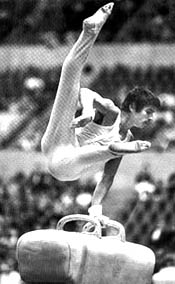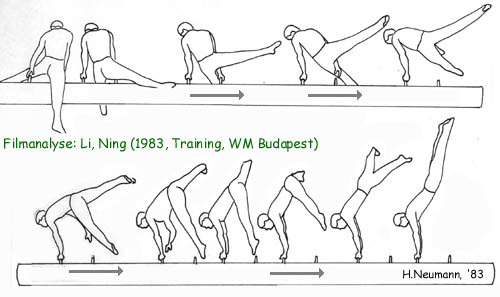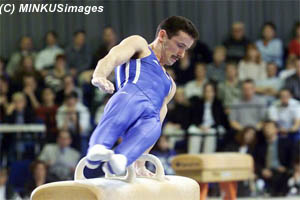 |
 The
technic on Pommel horse
The
technic on Pommel horse
The oldest
description of gymnastics on an artificial horse is over 600 years old.
It was written by a Renatus Vegetius , who, in his four volume “Overview
of the Roman Army”, describes soldiers using a wooden horse for practice.
In the 17th century a drill- instructor developed the art of equestrian
acrobatics from this description. In the early 19th century the wooden pommels
were replaced by a biegel, and the wooden horse developed into a schwingel'
covered in leather.
|
|
Today's
fascinating and dynamic routines on a modern pommel horse are
hardly reminiscent of the early forms of movement on this apparatus.
The development was massively influenced by the flexible and innovative
solutions offered by renowned apparatus manufacturers... |

German
|
|
|
|
Trends
of Pommel Horse Routines of the Past Five Decades (II)
(by Heinz Neumann, international
judge for many years)
|
|

Heinz Neumann
(Germany)
|
About
the author
Potsdam native Heinz Neumann
(born 1931, November 20, )
- was a coach at the former Army Sports Club "ASK Potsdam"
in Potsdam,. Germany, from 1954 to 1992. He also served
as head coach for the GDR team at the 1964 Tokyo Olympics.
Later on, he, who has always loved paying special attention
to details, focussed on the specialities of the most complex
of apparatus, pommel horse.
He was the first A judge in history (i.e. second head judge,
responsible for difficulty and special requirements) and was
a judge at every major international competition from 1965 to
1971. He judged his first competition in 1958 and continued
judging internationally until the mid 1990s, and is an active
judge until this day.
<< Heinz
Neumann is considered
one of the most knowledgeable pommel horse experts world wide,
who has a particular reputation of having a knack for details.
|
|
|
. |
|
The
1970s - The Magyar Years |
|
|

Zoltan Magyar (HUN)
|
Hungarian pommel
horse virtuoso Zoltan Magyar
heavily contributed to the development of pommel horse work
Further structural improvements to the horse facilitated these
developments.
It would take a few more years
for the old name "side horse" to make way for "pommel
horse". The "Magyar spindle" is to this day
a specifically Hungarian element of the highest difficulty
which is rarely shown.
The innovation of the Thomas
flairs, which had actually been performed by Canadian Delesalle
before Kurt Thomas
(USA) at the 1976 Olympics, was a sensation.
Soon, gymnasts
started constructing entire routines from this type of elements,
forcing the FIG's technical committee to put a stop to this
by changing the code of points.
|
|
The
1980s - cultivation of the Thomas flairs |
Gymnasts
used Thomas flairs in any possible variation in their routines. Combined
with handstands, turns in handstand, they still remain one of the most
common dismount combinations to this day.
| |

Swings
in the straddled position were brought to handstand by most
gymnasts in the early 1980s.
Li Ning showed a spectacular
front scissor with ¼ turn. But fear of possibly pausing in handstand
and the ensuing deductions stood in the way of an inflation
of such elements.
|
|
|
The
1990s spindles with turns |
The
first half of the 1990s was marked by the flaired spindles with 1/2
turns and the full spindle in one or two circles. These were missing
from hardly any top routine. Gymnasts began showing various support
positions on the apparatus. When
these elements were downgraded, they disappeared from most routines.
|
A
new millennium of gymnastics no more flops |
|
The
new rules from 2001 on no longer allow the endless combinations of bonus
elements, like the "quadruple flop" which generated
0,6 in bonus alone. Only one flop is allowed now (immediate
Stoeckli B on one pommel, 0,2 in bonus). The maximum bonus
for this is now 0,3 (instead of the previous 1,1 pts).
But now the new Code of Pointage, which is lawful from 2006
on,
that's a very new period of gymnastics history....
Author: Heinz Neumann,
Potsdam;
(Editor: E. Herholz, GYMmedia)
|

Marius Urzica (ROU)
- the "pommel
artist" of the Nineties.
|
|
|
. |
|
|

|
|
|
|